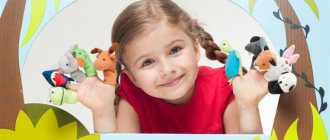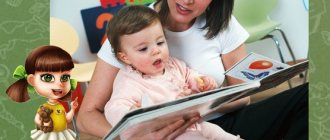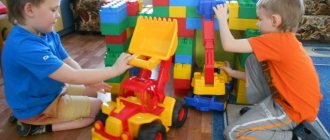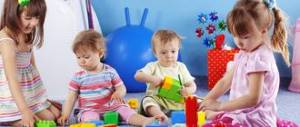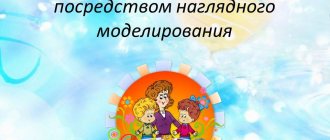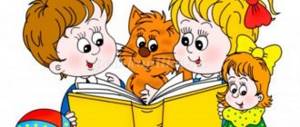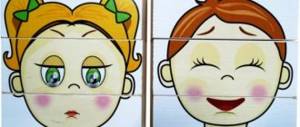How does memory work in preschool children?
Before moving on to a description of the principle of using mnemonic tables, it is necessary to dwell on the features of memory development in preschoolers. First of all, it is important to say that in the majority of preschool children, figurative memory predominates (this can be visual, as well as auditory, olfactory and other images of perception). At the same time, children remember information mainly mechanically, involuntarily. That is, the child remembers what interests him or what makes a strong impression on him. Therefore, an unusual and bright form of presentation is very important. With the development of speech, children's ability to perceive words increases: a preschooler can memorize poetry, he easily remembers the plots of fairy tales and cartoons. However, according to psychological and pedagogical research, it is much easier for children to reproduce information if in the process they can rely on visual diagrams. In older preschool age, the child begins to form voluntary memory. With the development of the ability to self-control, the baby learns to independently remember information that may be useful to him. It is visual aids (diagrams, sketches, notes) that allow children to better remember the necessary material.
Preschool children have the most developed figurative memory, therefore, in order for the child to better remember any information, it is necessary to use various visual aids, including mnemonic tables.
Using mnemonics methods in teaching preschool children
Bibliographic description:
Volkova, V. E. Using mnemonics methods in teaching preschool children / V. E. Volkova. — Text: immediate // Current tasks of pedagogy: materials of the IX International. scientific conf. (Moscow, June 2020). - Moscow: Buki-Vedi, 2020. - pp. 18-20. — URL: https://moluch.ru/conf/ped/archive/279/14285/ (date of access: 10.10.2020).
The use of mnemonic methods in the development of preschool children is becoming increasingly relevant. The relevance of mnemonics for preschoolers is due to the fact that at this age figurative memory predominates in children, memorization often occurs involuntarily, and its productivity increases with visual reinforcement. Mnemonics helps speed up the memorization process in preschoolers, develop figurative, logical, associative thinking (including the ability to systematize, analyze, isolate parts, combine into pairs, groups, the whole), imagination, attention. In addition, the use of mnemonic techniques enriches children's vocabulary and promotes the formation of coherent speech. Children develop the prerequisites for self-education, the ability to conduct introspection, children become more liberated and independent [4].
Mnemonics methods can be taught either in the form of an independent lesson, or its elements can be included in various types of classes and even in various types of children’s activities.
An analysis of publications on the use of mnemonics in kindergarten showed that the emphasis in working with preschoolers is on the development of memory and speech.
The most accessible and widely used by preschool teachers is the “cropping” method - the use of mnemonic tables, collages, drawings, diagrams, sketches, sketches.
A mnemonic table is a diagram, a structure in which various information can be included.
To begin with, children are introduced to mnemonic squares - clear images that represent one word, phrase, its characteristics or a simple sentence. Then the task becomes more complicated, a mnemonic track is demonstrated - this is a square of four pictures, from which you can compose a short story in 2-3 sentences. And finally, the most complex structure is mnemonic tables. They are images of the main links, including schematic ones, from which you can remember and reproduce an entire story or even a poem [1].
The use of mnemonic tables in working with children allows them to better perceive and process visual information, recode, store and reproduce it in accordance with the assigned educational tasks.
In preschool education, developmental and educational mnemonic tables are used [8].
Developmental mnemonic tables are aimed at developing basic mental processes: memory, attention, imaginative and logical thinking. The children are shown a table and the encoded information is deciphered. Logical connections, quantitative and qualitative characteristics are established. Then you are given time to memorize the table. The table is removed and the children reproduce it graphically from memory.
Educational mnemonic tables can be used in work in any educational field, they allow you to more productively remember material on lexical topics, facilitate learning storytelling, literacy (memorizing letters, rules), memorizing poems, proverbs, contribute to the correction of violations of sound pronunciation, work on differentiating sounds, the formation of elementary mathematical ideas, familiarize preschoolers with nature, contribute to the education of cultural and hygienic skills, the formation of ideas about dangerous situations and methods of behavior in them, the development of cognitive and research activities, familiarization with the surrounding social world, the formation of ideas about types of art, the implementation of independent creative activities, and the improvement of skills in visual, constructive and modeling activities, the formation of initial ideas about a healthy lifestyle, the improvement of skills in basic types of movements, physical exercises, activity in independent motor activity, etc.
Working with educational mnemonic tables is somewhat different, since they contain educational information, usually unfamiliar to children, so the main role belongs to the teacher, especially if this is the first mnemonic table in a certain direction [7].
Initially, the tables are compiled by teachers and parents, then the child can be involved in this process, the main thing when compiling tables is that the pictures are connected with each other, because children, in order to memorize the tables, must make up a story or connect them in meaning, or classify them.
Collages are educational aids that solve the problems of developing photographic memory in preschoolers, expanding vocabulary, and imaginative perception; the ability to speak and tell stories that fulfill the task of teaching children [6].
A collage is thick paper (cardboard, flannelgraph) of various formats (depending on the purpose), on which various pictures, letters, geometric shapes, and numbers are pasted, superimposed or drawn.
The apparent chaos of pictures superimposed on the format is the essence of the collage.
Children are explained that a collage is similar to a “salad”, when they take many different products and combine them together to get a tasty dish. Therefore, the first and main task of a collage is to connect, that is, to connect all the pictures with each other. Thus, the plot method of memorization is being developed.
Examples of using collages in the speech development of children: exercise “Reading a letter from a picture” - children receive a letter - a diagram, which they must decipher; game “Traffic Light” - children must determine the place of a certain sound in a word and lay out the diagram cards in order, this will be a hint for children in reproducing a chain of words [6].
Sketching words makes it possible to develop children's imagination, thinking, and creative abilities, promotes memorization of words, and makes them think. Thanks to sketches, children remember poems faster; using sketches, you can offer to guess a poem already familiar to children. A very effective technique is sketching at the initial stage of learning in the game “Chain of Words”, where children make sketches for themselves, depicting a word they hear. Thus, children get a chain of drawings from which they can easily remember all the words. This game can be made more complicated by asking you to close your clues and remember what was drawn, or you can also remember and reproduce the sketches from memory on another piece of paper.
The method of associative chains or the “nonsense” method is that children make up a story - “nonsense” from the proposed words or a set of pictures; they seem to be fooling around and in such a game they quickly remember the chain of words. For example, the words: bird, ball, leaf, kitten, etc. With these words we come up with the story “The bird is playing with a ball, the ball is fanning itself with a leaf, the leaf bit the kitten, etc.” At first glance, this seems complete nonsense, and children associate every word with some action, location, etc. You can play games like “What’s missing” and “Confusion” [5].
Having analyzed the experience of using mnemonics in working with preschoolers, we found that for the development of coherent speech, the most effective would be to use the “cropping” method (mnemonics, collages, drawings, diagrams, sketches, sketches). This method in preschool pedagogy is called differently: sensory-graphic diagrams (V.K. Vorobyova), subject-schematic models (T.A. Tkachenko), square blocks (V.P. Glukhov), collage (T.V. . Bolsheva), scheme for compiling a story (L. N. Efimenkova), scheme-model (L. E. Belousova).
A special place in working with children is occupied by didactic material in the form of mnemonic tables, collages and diagrams, which significantly makes it easier for children to master coherent speech; In addition, the presence of a visual plan makes stories (fairy tales) clear, coherent and consistent.
Working with mnemonic tables is built from simple to complex.
T.V. Bolshova [3] recommends starting work with the simplest mnemonic squares, then sequentially moving on to mnemonic tracks, and later to mnemonic tables. She offers ready-made mnemonic tables for composing stories, and L. E. Belousova [2] believes that for better memorization, children themselves should come up with and sketch symbols in the proposed diagram. T. B. Polyanskaya notes that for children of primary and middle preschool age it is necessary to give colored mnemonic tables (fox - red tail, Christmas tree - green triangle), and for older preschoolers - black and white [5]. The authors propose the following technology for working with mnemonic tables:
- examining the table and analyzing the symbols depicted on it;
‒ recoding information (converting symbols into images);
‒ retelling of the work by the teacher based on symbols (the initial stage of working with mnemonic tables), by children together with the teacher or by the children themselves.
T. B. Polyanskaya notes the need to work with children to learn to read symbols. She points to a lot of preliminary work for GCD on speech development with the help of mnemonic tables: preparation of additional cognitive material that expands the horizons of children: discussion with children of what they saw on excursions, observations of natural phenomena, works of art; preparation of equipment and handouts; the teacher’s choice of techniques that may interest children in the lesson. In the GCD, the author includes a discussion on the topic (“What do you know about this?”), outdoor games, word games, listening to music, reading poetry, sayings, folk signs, etc. The main part of the GCD is the compilation of descriptive stories using mnemonic tables and diagrams - tables (from the preparatory group). To consolidate the acquired knowledge, together with the children, the teacher prepares albums on the covered topic with children's stories and drawings [5].
Teachers of preschool institutions widely use mnemonics when organizing other types of activities for preschoolers: to enrich the vocabulary of preschoolers, when teaching how to write stories, when retelling works of art, when guessing and making riddles, when memorizing poetry, when working with fairy tales, when introducing preschoolers to nature , in cognitive cycle classes. For example, the topic “Animals”: appearance (body parts); place of residence (cow barn, kennel, pigsty, etc. (for domestic animals) or den, lair, burrow, etc. (for wild animals); what it eats; what is the name of the cub; what benefits does it bring to humans (to describe only domestic animals); in which fairy tales or cartoons does this animal appear?
Thus, the use of mnemonic techniques in working with preschoolers is a popular area, allowing not only to speed up the process of memorizing information, but also to develop mental processes and visually present the material being studied. The “crocking” method (mnemonic tables, collages, diagrams) helps to successfully cope with the task of developing coherent speech in preschoolers, which is confirmed by the results of the work of practicing teachers who describe their experience in this direction.
Literature:
- Barsukova E. L. Automation of sounds using mnemonic tracks // Speech therapist. — 2009.- No. 5. — From 18–23.
- Belousova L. E. Learn to retell? It's simple! - St. Petersburg: Litera, 2009–65 p.
- Bolshova T.V. Learning from a fairy tale. Development of thinking of preschoolers with the help of mnemonics: Educational and methodological manual. 2nd ed. corr. - St. Petersburg: Detstvo-Press, 2005. - 96 p.
- Guryeva N. A. Exercises on mnemonics. - St. Petersburg: Firefly, 2000.
- Polyanskaya T. B. Using the method of mnemonics in teaching storytelling to preschool children - M.: Detstvo-press, 2010–64p.
- Svatkova L. A. Experience in using mnemonics in the development of preschool children. — Access mode: https://dohcolonoc.ru/cons/3794-ispolzovanie-metoda-mnemotekhniki-pri-oznakomlenii-doshkolnikov-s-mirom-professij.html
- Spynu V.V. Teaching the compilation of descriptive stories for preschoolers with special needs based on the use of mnemonic tables // Young scientist. - 2013. - No. 11. - P. 654–657.
- Tkachenko T. A. Compilation of descriptive stories using reference diagrams Method. manual, picture kit. — M.: Knigolyub, 2014
Key terms
(automatically generated)
: child, collage, work, coherent speech, preschooler, game, story, word, writing stories, diagram.
What are mnemonic tables?
Mnemonic tables are diagrams consisting of sequentially arranged image-symbols in which the content of texts (fairy tales, poems, etc.) is encrypted. Thanks to them, the child can perceive information not only auditorily, but also through visual images. The formation of additional associations facilitates the memorization process and helps to reproduce learned material. Most often, mnemonic tables are used for memorizing poems, teaching retelling, composing stories, as well as for memorizing rules and various sequences. But memory development is not the only positive consequence of practicing using mnemonic tables. Children actively develop logic and imaginative thinking, attention, imagination, their vocabulary expands, and beautiful and coherent speech is formed.
It is best to introduce the baby to mnemonics in several stages according to the principle from simple to complex:
- A mnemonic square is a separate card with an object, action or phenomenon schematically depicted on it, in which one word is encrypted (for example, “cup”, “run” or “rain”).
- A mnemonic track is a combination of several linearly arranged mnemonic squares, which can be used to compose a phrase or sentence.
- A mnemonic table is a more complex design consisting of many mnemonic squares, which contains quite a lot of information.
The number of mnemonic squares that make up a track or table depends on the age and other individual characteristics of the child. For children 3-5 years old, small patterns containing 4-8 cells are suitable. With older preschoolers 5-7 years old, you can use tables of 8-16 squares. Mnemonic tables for children must be colorful and bright, so it will be easier for the child to concentrate his attention. For older children, black and white pictures are also suitable. It is important that the images are familiar and understandable to the baby.
When working with mnemonic tables, both hemispheres of the child’s brain are involved: the left, which is responsible for logic and sequential analysis of information, and the right, which is responsible for imaginative thinking and imagination.
Mnemonics for kids: games for memory and speech development (with links to download material)
I started writing a post about our games for speech development, but it turned out to be so huge, and so far it’s such a mess that I decided to write in parts. Today is my post about mnemonics for kids.
Mnemonics
— methods and techniques that facilitate the process of memorizing information. This happens by encoding information into visual, graphic or auditory images. Thus, when working with mnemonic techniques, memory improves, associative thinking is activated and, as for children, speech develops.
There are a huge number of mnemonics developed, in particular, by famous people. For example, Cicero’s method, aimed at spatial imagination (well written about it here), or Aivazovsky’s method, based on visual memory training. A lot of information about all this can be found on the Internet.
Each of us, perhaps without knowing it, is familiar with mnemotechnical techniques. Here, for example, are mnemonic phrases.
Ivan gave birth to a girl, ordered her to drag a diaper (to remember the cases of the Russian language)
Every Hunter Wants to Know Where the Pheasant Sits (to remember the sequence of colors of the rainbow spectrum)
I often use this one: “Dress Nadezhda, put on clothes”
Or, I like it: Dear Hokkaido! I love you Khonshu. For your Shikoku, I give you Kyushu - to remember the four main islands of Japan.
So, I got carried away, I can continue ad infinitum). Stop. Now about the children.
Here I will write about mnemonic games with PICTURES. I’m sure all children love to look at pictures, which are a great help in developing a child’s speech and expanding his vocabulary. Ushinsky was right when he said: “Teach a child some five words unknown to him, and he will suffer for a long time and in vain over them; But associate twenty of these words with pictures, and the child will learn them on the fly.”
1. The first thing I want to write about is mnemonics
. The idea is simple: a picture is drawn for each word or phrase and the entire text is written down in the form of an illustrated diagram (in scientific language this method is called crocking). Speech therapists suggest starting mnemonic exercises with a child from simple to complex
-Mnemonic squares.
-Mnemonic tracks
-Mnemotables
(I took the example from here)
Ulyasha and I somehow skipped the stage of mnemonic squares and went straight to the tracks and even tables. To begin with, I decided to make mnemonic preparations for the poems known to Ulyana, so that she would understand the “rules of the game.” This is how we play. We read, name the drawn images, then the daughter runs to her bookshelf and looks for a book with this rhyme. We look for the desired page and add a bookmark. That is, a game that even resembles lotto in principle.
And here is Ulyasha, passionate about the game
After some time, I’ll cut everything into squares, and Ulyasha will lay out the sequence of the poem. At a later stage, it is expected that the child will draw the images of the verse himself. Mothers who have practiced such games note that the child remembers the poem on the fly. Of course, the process is turned into an exciting game!
Another example of mnemonics are the numerous “ABCs” in verse. We only have Marshak’s “ABC” for now, but I’m not purposefully learning letters with my daughter yet, so that’s enough. And here is 1 of our mnemonic tracks.
Mnemonics are also acrostics, that is, those in which the initial letters of the lines form a word or phrase. But this will be interesting for children who already read.
There are a great many ready-made mnemonic tables on the Internet. For example, here you can download thematic ones.
And here is another example of mnemonics, this time for remembering colors.
Each “colored” image is represented by a picture - a stencil, which we put on a card of the desired color. In the photo we played with “blue” cards. The material can be downloaded here
We also memorize poems by playing with flannelgraph. Ulyana loves, for example, Marshak’s poem “Where the sparrow dined.” I read the verse, pause at the right place, Ulyana looks for the animal, names it and pins it to the board.
Pictures for flannelgraph can be downloaded here
2. Close to mnemonics of stories in pictures
, where pictures are drawn instead of words.
Stories like these can significantly enrich a child's vocabulary. For example, vegetables can be studied by reading a story like this.
There are many ready-made stories on the Internet. For example, here
For Ulyasha, such pictures are still a bit complicated. We started with something simpler. To begin with, I made a preparation for the fairy tale “Ryaba Hen,” which my daughter knows by heart.
And here is another version of our games. I write stories about Ulyanka. At the end, some task is given. It's not very visible in the photo. The picture shows a story about how a mouse, a cat and a dog came to visit Ulyana. Ulyana prepared a treat for everyone. And they also brought Ulyasha a delicious gift. Assignment for my daughter: put some food on a plate, choosing from a variety of cards. That is, it turned out to be a game for distinguishing lexical topics (edible-inedible; food-clothing). And of course, Ulyasha is delighted. What child wouldn't love a story about himself!
Many mothers complain that children do not stop for a long time on page 1 of a book, quickly flipping through everything. Stories like these in pictures teach you to focus on one page. Ulyasha and I “read” by moving our fingers))))
3.Sequence games
. The most mnemonics))) For example, such a picture can often be found in kindergartens.
This makes it easier for kids to remember the dressing algorithm. Many mothers at BB give their children the task of decomposing a sequence. Ulyana and I, for example, recently laid out this sequence
Another good game for determining the sequence is lacing with characters from the fairy tale “Turnip”. And motor skills develop at the same time!!!
4.
There are many games based on mnemonics in the method of
M. Shichida
- Memory Grid. We play in several ways.
1. I lay out the cards in front of my daughter, look at them for a few seconds, turn them over and ask: “Let’s remember where I hid...”. We don’t have photos of the process, but you can see this method in Lisa’s video
2. I lay out the cards, look at them for a few seconds, turn them over, and give out a second set of the same ones. Ulyana puts them on top, looks for a pair blindly, turns them over, checks
3. I draw the pieces of paper into squares, glue the stickers, and let Ulyana look at it for a few seconds. I'm cleaning up. I give out the same piece of paper lined up with squares and a set of the same stickers, and we look for the right house.
I like this version of the game the most.
— Linking memory. I can’t write about this game better than Lisa))) We play the same way as Lisa and Alice
— Photo memory. We show the child the picture for a few seconds, remove it, take out 2 pictures, the same one and one very similar to it. (for example, on one there is a girl with a red bow, on the other with a blue one), the child must point to the one that we showed first. Close to this game are mandalas. We read about this from Lisa. And download the material here and here
5. Ulyana also likes the game “Day-Night”. I lay out the cards in front of her, let’s take a look. Then I say, “Night has come,” and my daughter closes her eyes and covers her face with her hands. At this time I hide one picture. I say: “The sun is out, the day has come, let’s wake up.” Ulyanka opens her eyes and guesses “Who/what is hiding”
6. Games to develop tactile and auditory memory
Tactile balls and noisemakers are popular with Ulyanka. The photo can be seen here at the end of the post.
It's fun to play with the tactile bag. We put different items in a bag. At Mom’s request, the Kid must reach for the object with his hand, guessing it by touch.
Auditory memory can be developed through sound lotto. For example, give your child cards with pictures of animals and find the sounds they make. Turn on one by one, and the baby must find the right card.
Another option for those whose kids love cartoons. We download songs, for example, Winnie the Pooh, Troubadour and Uncle Fyodor's mother. We print out images of the characters. We turn it on one by one, the child selects the picture.
Well, a very complicated version (for older children). We give out portraits of classics (Mozart, Beethoven, etc.), play plays, and the child selects pictures.
At the moment, Ulyasha and I are playing like this. We have a book based on Entin’s poems for cartoons.
I downloaded all these songs. I turn on one at a time, and Ulyanka looks for the page with the desired verse. My daughter really likes it. When we played for the first time, she carried this book to me all day long))) Here is her favorite spread and song)))
By the way, we don’t watch cartoons yet. I can imagine the delight that awaits the child when we start watching them!
I'm finishing up about our games for now))).
For mothers of children older than my Ulyanka, I suggest you look at other interesting games using mnemonics here
And there is also a book by T. Polyanskaya «
Using the mnemonic method in teaching storytelling to preschool children
."
You can download it here
I hope such a long post did not bore you, and maybe it was useful to someone.
Our mnemonic preparations and other materials can be downloaded here
P/S. I see that my post was useful and relevant. Girls, let's join forces and post links to our mnemonics right here, in the comments to the post
. Julia and Lyubov have already done it!
Happy games!
How to create a mnemonic table yourself?
When working with your little one, you can use both ready-made mnemonic tables and ones you make yourself. In order to make a table based on a poem or story, you need:
- Divide the text into fragments (the younger the child, the shorter).
- Draw squares on a piece of paper according to the number of text fragments.
- In each square, depict what is said in the fragment, or what is associated with it. A child of senior preschool age can independently draw pictures for the table.
- If you wish, you can sign the text in each square that you need to remember.
Examples of mnemonic tables for preschoolers
- Mnemonic tables for learning poems
To make it easier for your child to remember the poem, you can use mnemonic tables:
- Read the poem to your child with expression.
- Then you need to tell your child that now you will learn the verse by heart together. After this, read the text again, but at the same time pay little attention to the table.
- Discuss the content of the poem, its main idea.
- Find out whether all the words and pictures are clear to the child, explain their meaning.
- Read line by line and ask your child to repeat after you, based on the pictures.
- Then the baby can try to recite the poem on his own, looking at the mnemonic table.
You can see an example of memorizing a poem using mnemonic tables in the video:
- Learning to retell and compose a story based on a diagram
Preschool children, although they have a fairly extensive vocabulary, often have difficulty composing stories. Kids are easily distracted, confused, and lose the logic of their thoughts. Mnemonic tables help children plan a story and reproduce plot events in the correct order.
How to simultaneously develop memory and coherent speech, expand your vocabulary
The most effective method in the development of preschool children in mnemonics is play. Schemes are also suitable. Development methods include:
- Give the child separate pictures. The kid should try to group them and explain why he put some pictures together;
- depiction of your impressions. This method allows you to develop your vocabulary. It is necessary to invite the child to draw his impressions of the past day. Then the baby must tell what was good and what was bad about his day;
- memorizing poetry. To make it easier to memorize poetry, you need to use tables. Each row of the table must contain a sign or picture;
- Show the baby a picture. Tell what is depicted on it. Next, the picture is turned over, and the child must name the elements that were depicted;
- solving crossword puzzles;
- lay out pictures in front of the child. The child looks at them carefully. Then he closes his eyes and the adult removes one picture. The child opens his eyes and says which picture is missing.
Development of preschoolers
Charts and tables for quick memorization
The easiest way to remember numbers and letters are diagrams and tables. For example, to help your child remember numbers, you can draw diagrams. They contain numbers and associations to them.
Speech therapy massage for children
| 1 | Pencil pen |
| 2 | Goose, rooster |
| 4 | Armchair sofa |
| 7 | Knife |
To remember the letters you can make a table. The first column contains the letter, the second column contains the words that begin with it, and the third column contains the image.
| A | Watermelon, Pineapple, Apricot |
| B | Hippopotamus, Alarm clock |
| IN | Crow, Fork |
| G | Mushroom |
| D | House, Tree |
